Affiliate disclosure: This post may contain affiliate links. Please see our Privacy Policy.
Chaga is a fascinating medicinal mushroom that is vastly different from other mushrooms or herbs you can forage. As we’ll explain later, this “half-fungus half-plant” commonly regarded as the “Chaga Mushroom”, has a unique assembly of medicinal components and a flavor that is nothing short of extraordinary. In my opinion, it surpasses the taste of other medicinal mushrooms tenfold, and many people regularly enjoy it as tea or “chaga coffee.”
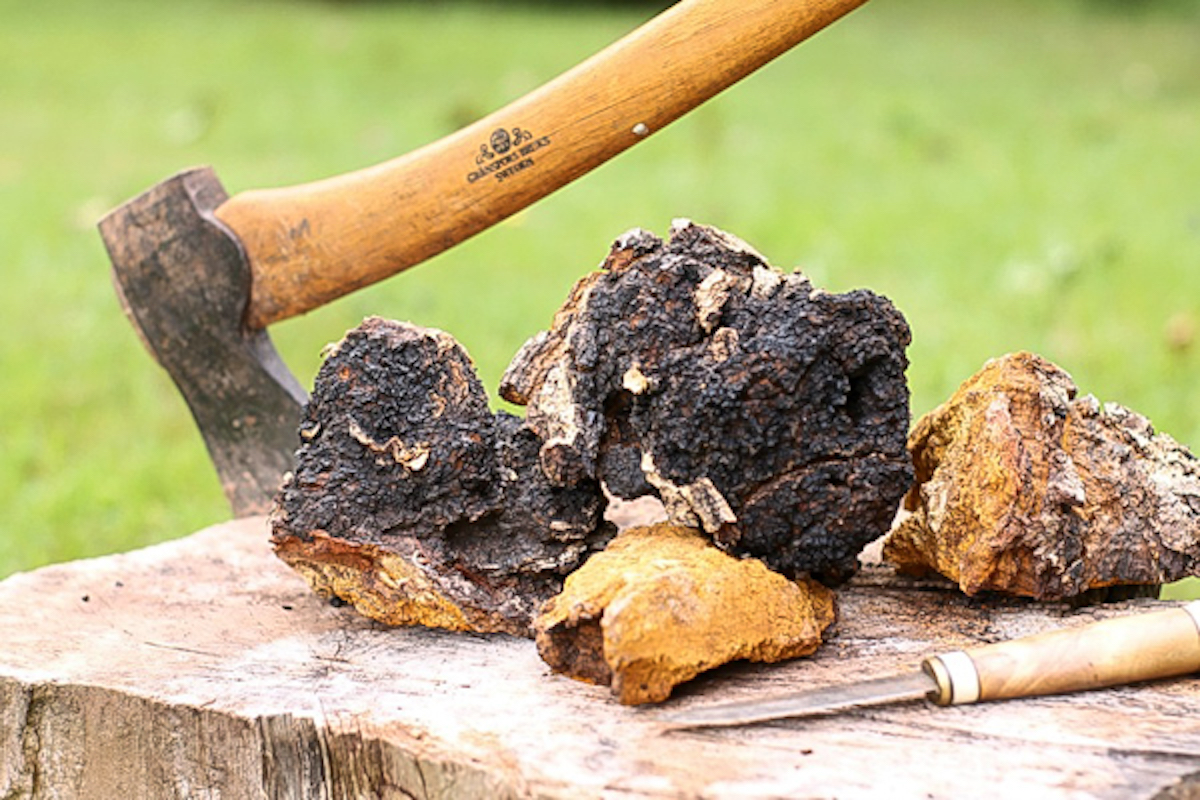
The first time I tried Chaga, I was pleasantly surprised to find out it had a soothing and inviting flavor. Being familiar with the bitter-tasting Reishi and the earthy Turkey Tail, I wasn’t expecting to be immediately gratified by the taste of Chaga. Don’t get me wrong, I’ve grown to enjoy the taste of these other mushrooms, but they have an acquired taste that not everyone enjoys at first; like a bitter beer or a strong coffee.
Chaga is different. It’s aromatic, fruity, and has hints of vanilla. Some specimens can be exceptionally fruity, with notes of cherry or raspberry, while others have a stronger caramel or vanilla flavor.
The delicious taste isn’t the only thing that makes Chaga unique. What is commonly regarded as the “Chaga Mushroom” is not actually a mushroom, but a tumor-like canker resulting from the complex relationship between a fungus and its tree host. The result is a growth with a unique cocktail of plant and fungal compounds that offer potent therapeutic qualities.
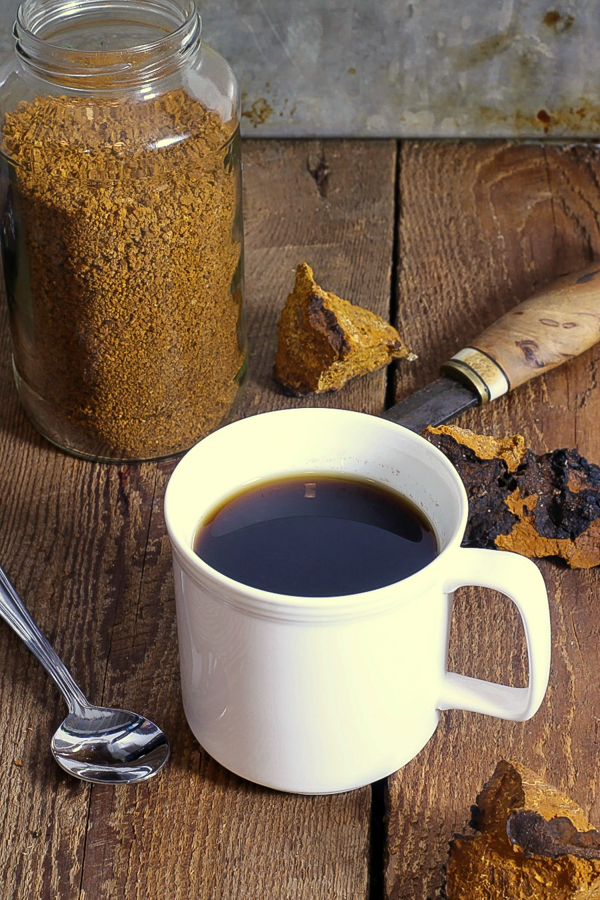
So… What exactly is Chaga?
Most people wouldn’t even have the slightest idea that Chaga was a fungus if they unknowingly stumbled upon it in the forest. It’s a strange, black, and relatively circular mass that grows directly on the trunks of Birch trees. Botanically speaking, it is considered a canker, a term used to define many different tumor-like growths that occur in plants. It’s no surprise that the term canker actually has an etymology that originates from the word “cancer”, due to the sickly tumorous growth.
The Chaga canker is the result of a fungal infection caused by the fungus Inonotus obliquus. This fungus feeds off the tree’s tissues and forms dense clusters of fungal mycelium known as sclerotia. The closest relatives of this fungus form more typical polypore mushrooms, but in the case of Chaga, this is far from true.
When the Chaga fungus infects the tree, it begins growing below the bark in the cambium layer. This causes changes in the tree’s genetic expression and stimulates swelling via irregular cell division. It also causes the tree to create and concentrate various compounds of therapeutic interest, such as plant-based triterpenoids. The fungus not only alters these compounds into novel forms, but it also produces its own unique set of medicinal components.
This interaction between the tree and the fungus ultimately results in the strange black mass we know as “Chaga”. This black mass grows relatively slowly and can take over 10-15 years to reach an adequate size for harvesting. The actual mass is extremely woody because it is largely made of wood. One analysis suggests that only about 10% of the biomass of Chaga may be fungal-based (Glamočlija, 2015).
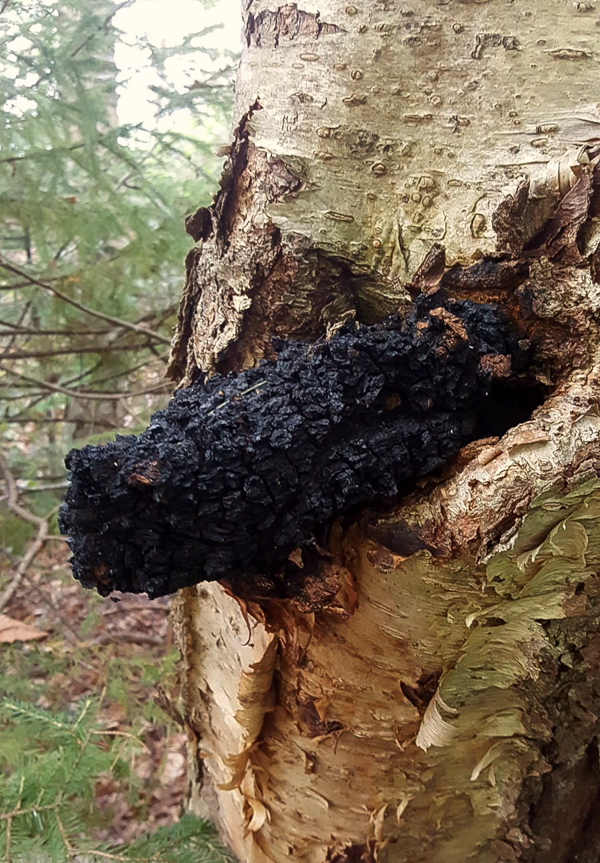
The Medicinal Properties Of Chaga
Traditional uses of Chaga can be found in Russia, Siberia, Canada, Alaska, and numerous First Nations in the Americas. Here it has been used to treat various ailments, including those related to skin diseases, viral infections, cancer, and digestive difficulties.
In Russia and various parts of Eastern Europe, it is well-known that Chaga has been consumed for hundreds of years. There are even tales of a Russian Duke who cured a cancerous lip tumor using Chaga in the 12th century. Indeed, in Eastern Europe, Chaga has a history of being used for the treatment of cancer and stomach ulcers. It was also commonly consumed as a cheap substitute for coffee and tea in rural parts of Eastern Europe. In some cases, Chaga “tea” was used as an antiseptic wash for skin-related cleanses.
Today, Chaga has gained popularity due to its high antioxidant content, immunomodulatory properties, and use in cancer treatment. It is often popularized as the “King of Medicinal Mushrooms” and urban legend says it has the highest antioxidant content of all foods. While this latter statement has little traceability and is based on the outdated “ORAC” score for measuring antioxidants, various studies do suggest significantly high levels of antioxidants (Cui, 2005; Kim, 2008)
Medicinal Components of Chaga
- Triterpenoids: These are generally considered beneficial for immune function and include inotodiol, trametolenic acid, betulin, ergosterol, and betulinic acid. These also have some antioxidant properties. Ergosterol is also a precursor to vitamin D.
- Phenols: Chaga has various phenols, including the pigment melanin, which is very rich in polyphenols. Melanin is particularly concentrated on the dark exterior of the canker. The antioxidant content of Chaga is believed to be mostly derived from various forms of phenols.
- Beta-Glucans: These are the immunomodulating compounds found within many medicinal mushrooms. They are technically considered a type of soluble fiber and the beta-glucans found in Chaga have been shown to be particularly therapeutic.
Suggested Medicinal Properties of Chaga
- Immune Support (Kim, 2005; Chi-Sun, 2010; Fan, 2012)
- Anti-Viral (Pan 2013; Basai, 2021; Virusologii, 2015; Shubnev, 2011)
- Cancer Treatment and Prevention (Marta, 2011; Kang, 2015; Arata, 2016; Cha, 2006)
- Help With Diabetes (Xu, 2010; Hee-ok, 2007; Young, 2005; Young, 2006)
- Improved Brain Health (Giridharan, 2011; Xin, 2021; Han, 2019)
- Improved Gut Health (Debnath, 2012; Mishra, 2012; Xin, 2019; Hu, 2017)
While there is a lot of traditional and scientific support for the use of Chaga, clinical trials are still pending to determine its effectiveness and proper usage.
Safety of Chaga
Chaga is safe for most individuals, but it should be noted that there can be negative side effects.
- It is known to be a mild blood thinner, so it should not be consumed by individuals already taking blood thinners or medications that have negative interactions with blood thinners. For this reason, it should also not be consumed before undergoing surgery.
- Chaga also contains a fair amount of oxalates. These compounds are found in many foods, such as spinach and chocolate, and usually don’t cause any health problems. This being said, it can act as an anti-nutrient, and excessive consumption has been linked to kidney stones. For this reason, you may want to exercise caution when consuming Chaga if you have preexisting health conditions related to gastrointestinal disease, kidney health, or malnutrition.
- If you have a history of disease, it is recommended to consult your health care practitioner before consuming Chaga.
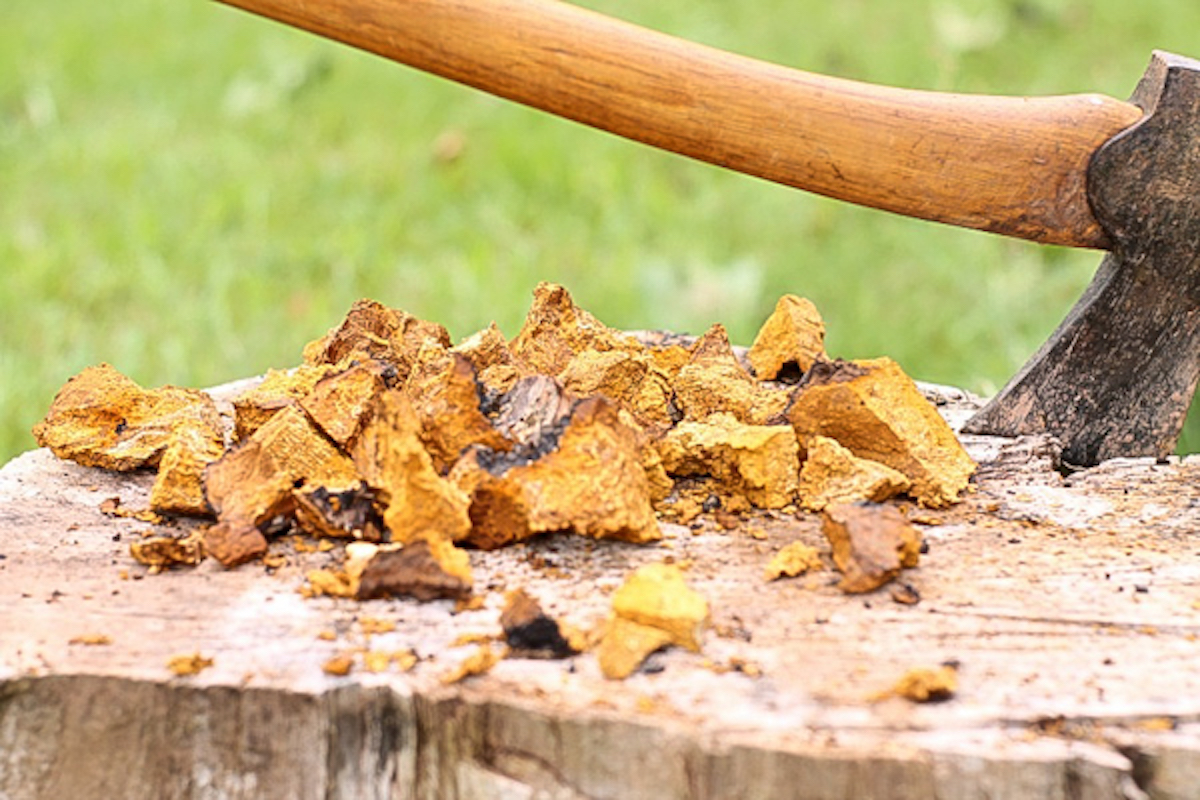
Foraging for Chaga
If you want to indulge in the health benefits and delicious flavor of Chaga, there is no better way than to forage it yourself. Not only is it a rewarding experience that brings you closer to this fabulous medicine, but it also ensures you are getting high-quality material that is sustainably foraged. This being said you should be well versed in how to properly find and identify Chaga because there are a bunch of different Chaga-like cankers that grow on the sides of birch trees.
Where to Find Chaga
As previously discussed, Chaga grows in association with birch. You’ll hear stories of people finding Chaga with aspens, alders, and poplars, but honestly, if you want my two cents, don’t even bother looking for Chaga on these or other tree hosts.
To begin with, the unique medicinal properties of Chaga are partially due to the compounds found in birch. Other tree hosts won’t contain these compounds. Second of all, many of these sightings may be misidentifications, as numerous cankers look a lot like Chaga. Even if there are forms of Chaga associated with these other hosts, their rare and elusive nature doesn’t make it worthwhile to “hunt” for Chaga on these other trees.
So, if you want to find Chaga, you must first find a birch forest. These are trees adapted to cooler climates and much more abundant in northern latitudes.
Finding Chaga in the United States
- Chaga and their Birch tree hosts are most abundant in the northeast from Pennsylvania up into Maine.
- You can also find them along the Appalachians in higher altitudes.
- In the Midwest, Chaga most abundantly occurs in the northern reaches near the border of Canada.
- Chaga is rare in most of the western United States, although it can be found rather abundantly in the boreal forests of Alaska. It has also been found in northern Idaho and northwestern Montana.
Other Parts of the World
- In Canada, you can find both birch and Chaga relatively easily in the expansive boreal forests that occur there.
- Chaga can be found in northern Europe and becomes more prevalent as you go north into the boreal forests, where Birch begins to dominate. Its range starts in northern Germany and becomes more common as you go north and east from there. It can also be found in the UK and has been found in the Alps.
- Chaga is not found in Latin America, Africa, the Middle East, or all of the southern hemisphere.
When to Forage Chaga
Chaga is most often foraged during the colder seasons of the year, and they’re one of the best muhsrooms to forage in winter. They’re also harvested in late autumn and early spring. This is mostly because the lack of foliage at this time of year makes it easy to spot. If there’s snow, the dark contrast of the Chaga amongst the white of the birch bark and snow makes it particularly easy.
It is also commonly stated that the medicinal properties are most concentrated during the winter, although in my research I have never found studies confirming this. This being said, harvesting during the winter may also be most beneficial for the tree host, as it is in dormancy and less likely to get an infection when there is cold and dry weather. Winter harvesting is traditional in many parts of northern Europe, so there’s probably a good reason for it! Plus, a warm cup of Chaga tea is more attractive when it’s cold out!
Another great thing about harvesting in the winter is that there are no other mushrooms, flowers, or herbs out there to distract you! This makes winter Chaga hunting a good excuse to go out in the midst of winter!
Identifying Chaga
Chaga is such a strange and unusual growth that it can be tricky for first-timers to distinguish them from other cankers and growths. In fact, the phrase “Is This Chaga?”, has evolved into an inside joke in the online mushroom community due to the dozens of people who innocently ask this question on identification forums. Thankfully, Chaga isn’t that hard to identify if you pay close attention to the following features.
Chaga Identification Features
- Growing primarily on birch. Birch has a distinctive white bark and triangular/oval-shaped leaves that are dropped in the fall.
- Chaga has a dark, charcoal-like exterior that is hard and crusty.
- The inside is a yellowish-light-brown with a consistent texture and color throughout the canker
- Spherical or slightly irregular and can be as small as a golf ball and larger than a basketball.
Chaga Lookalikes
No mushroom really looks like Chaga, but other growths and cankers can resemble Chaga. These can be caused by fungi, bacteria, or just strange growth forms on the tree. Lookalikes will never have the light-brown hazel color that you find in Chaga. Thankfully, if you do happen to make a mistake, none of these are known to be toxic.
Harvesting Chaga
To begin, when harvesting anything from the wild, it is important to do so with respect. Not only for the organisms you harvest but for the entire ecosystem and even human communities that may interact with them. Don’t leave trash, cause erosion, or conduct any reckless behavior that may harm the organisms that live there.
In some regions, harvesting Chaga should be done with the utmost respect due to the sustainability concerns associated with Chaga. It’s a relatively slow-growing canker with limited distribution, and overharvesting has become a concern in some parts of the world. For this reason, only harvest what you need and don’t harvest everything you see. Always leave smaller pieces so they can continue growing. A good rule of thumb is to always leave the first one you find and only harvest every other one after that until you have what you need.
Now, when it comes to harvesting the Chaga, you can’t really use the term “mushroom picking”. That’s because it’s a hard, woody growth that is well attached to the tree. At the very least, you are going to want a knife, but a hand saw is most recommended. A small axe can work too, although proper care should be taken not to damage the tree. Using your tool of choice, simply cut off the Chaga at the point where it attaches to the tree.
After harvesting, it is recommended to keep your Chaga in a dry and cool environment. Ideally, dry it in the sun or in a dehydrator, and then store it in an airtight container. It is best to keep it in as large of chunks as possible until right before use. This helps preserve its flavor and medicinal properties, which can evaporate or become oxidized once exposed to air.
How to Use Chaga
Chaga is typically consumed as a hot, soothing beverage. To do this, begin by breaking your Chaga down into small pieces. The smaller, the better, as this helps with the extraction process. If possible, grinding it into a powder using a coffee grinder or mortar and pestle is recommended. About 1-2 grams per person is a recommended serving.
Once you have your Chaga ready, it should be cooked in simmering water for at least 10-15 minutes. About 2-4 cups of water per serving is sufficient. If you want a more potent beverage, you can add more water and boil it down. The liquid should turn a dark coffee-like color once it is ready to drink. At this point, simply strain and enjoy! You can often take the left-over pieces of Chaga and decoct them again in simmering water, some people do this multiple times until there is no more pigment or flavor being released. The more you do this, the less potent it becomes.
Once you have your Chaga extracted, you can either drink it as is or further elaborate it into other beverages. You can use it to brew coffee, tea, or mix it with other herbs of your choice.
Double Extraction Tincture
Alternatively, many people may decide to make an easy-to-use tincture with Chaga. In some ways, this may be considered more effective, as alcohol extraction helps get the triterpenes and other non-water soluble compounds.
To make a double extraction tincture, simply fill a mason jar about 1/3–1/2 full of finely ground Chaga powder. Afterward, fill the jar with the highest-proof food-safe alcohol you can find; anything from 40% or higher should be fine. You are now going to let this sit for at least 2-3 months, regularly shaking the jar to help with the extraction process. After 6 weeks, strain the liquid and set it aside.
Take the remainder of your Chaga pieces and boil them in twice the quantity of water you used for the alcohol extraction. You can use more water for a more thorough extraction, although you will have to boil it down to reduce the water content. You now want to boil this for at least an hour to properly extract all the bioactive compounds. Some folks may decide to strain it and boil it again in fresh water to further extract the compounds, but again, you will have to boil this down.
Once you have your hot-water extract, you will want to mix it with your alcohol extract. The key here is that you want to have at least a 25% alcohol percentage to give your tincture a long shelf life. Really, 20% should be fine, but we calculate for 25% to make up for any alcohol lost during the making of the tincture. So if you use 40% alcohol in your initial extraction, you will want to use about 2 parts alcohol to 1 part hot-water extract. If you used 80% alcohol, you could use about 2 parts hot-water extract to 1 part alcohol.
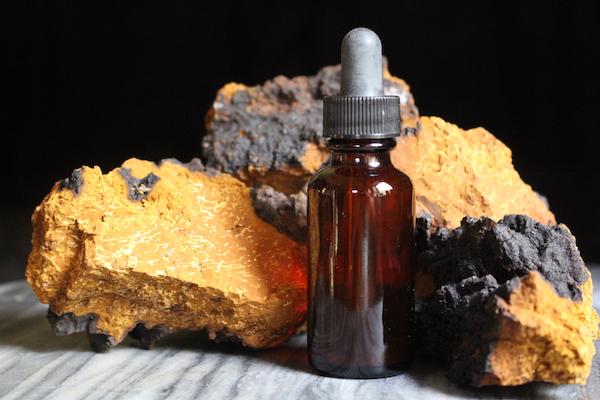
Other Uses For Chaga Mushrooms
While the most common use for Chaga is as a nutritional supplement, Chaga was also used by native cultures for other reasons.
When fully dried, Chaga makes an excellent ‘fire fungus’ due to its tenancy to smolder and not burn a flame. This allows you to light a piece of Chaga, and allow the ember to smolder, enabling you to carry the ember with you from campsite to campsite.
A fist-sized chunk of Chaga can easily smolder for 4 to 5 hours. The larger the chunk, the longer it will burn.
You can also use ground dried Chaga as a fire starter. All that’s needed is a flint and steel, to quickly light the dry powder.
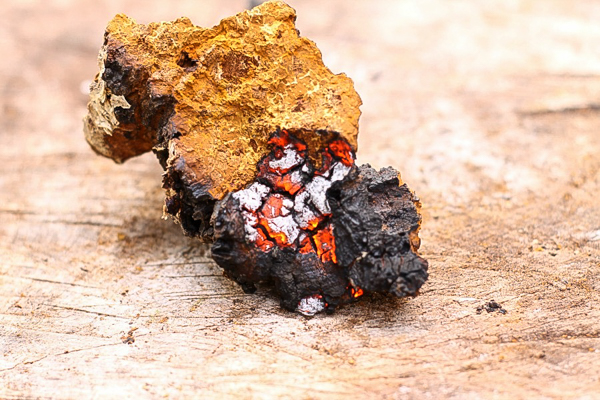
The other benefit to Chaga is the sweet-smelling smoke it produces. This scented smoke was used as ‘smudge’ by native cultures to keep mosquitos and other flies at bay as well as an incense in spiritual applications.
Author Bio
This article was written by Timo Mendez, a freelance writer and amateur mycologist who has foraged wild mushrooms all over the world.
Mushroom Foraging Guides
Looking for other Mushroom Foraging Guides?
- Foraging Birch Polypore
- Foraging Tinder Polypore
- Foraging Puffball Mushrooms
- Foraging Pigs Ear Mushrooms
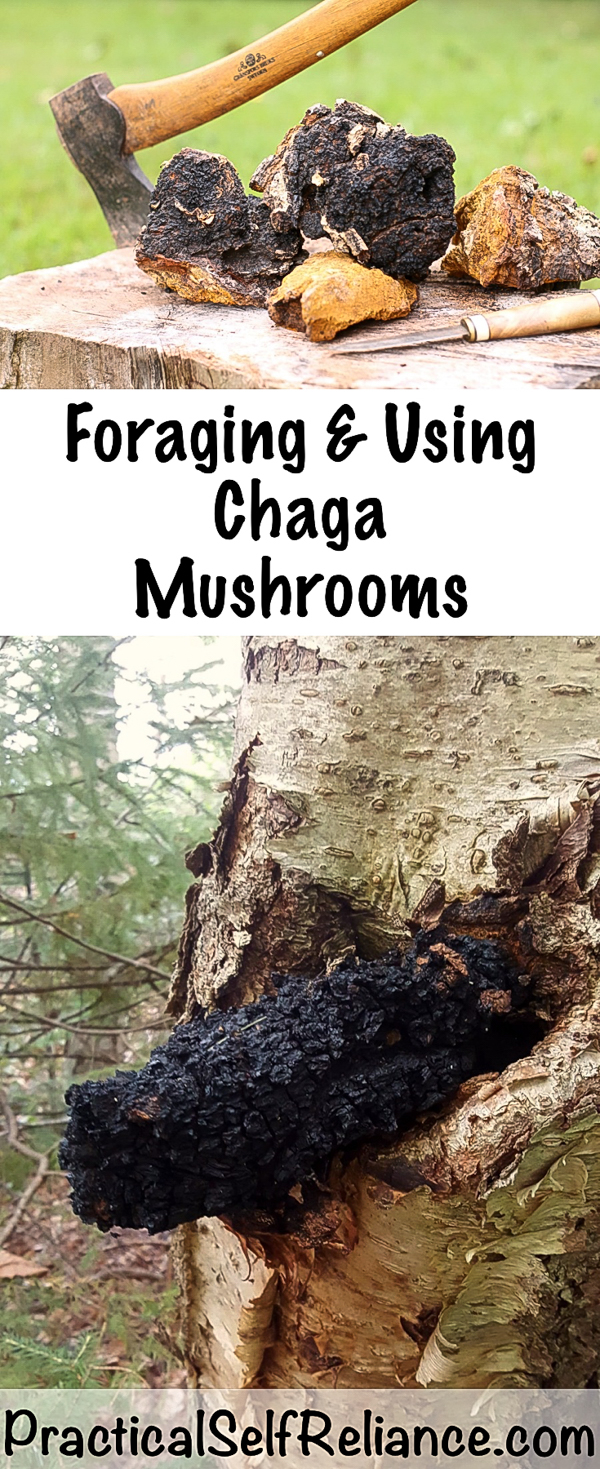

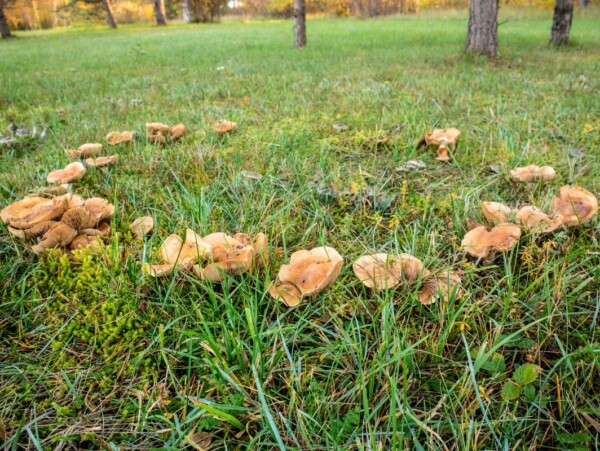
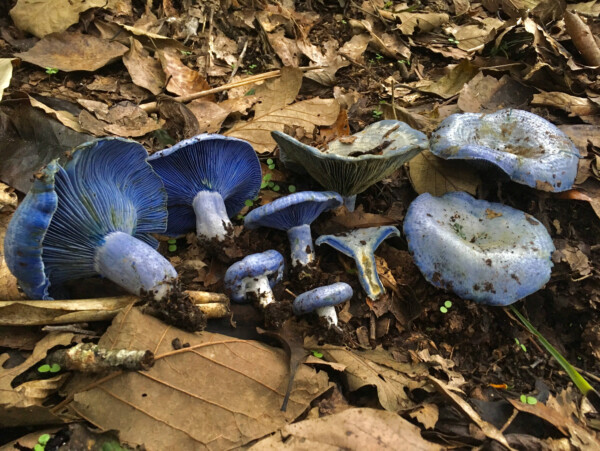
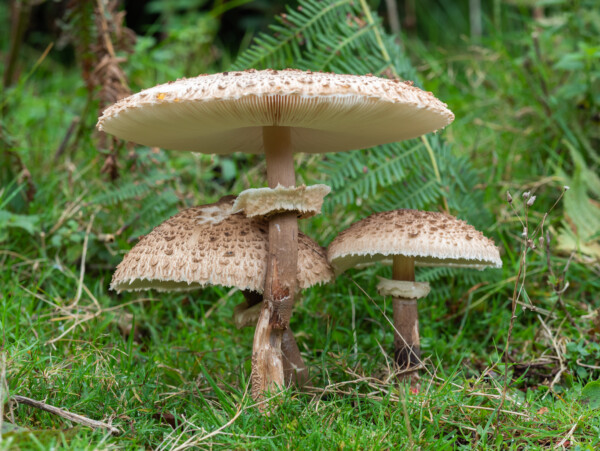
I’m looking for more ways to use natural plants and herbs to add to my life, watch Self Reliance often love the natural nature and sounds and of course Cassie Sean James is my hero and all his hard work and patience with neighbors, I don’t think I could have moved out of his Cabin Thanks for the info and I’m going to start looking for Chaga.
I’ve been thoroughly enjoying your site! It’s full of useful, practical and well-organized & written information on a host of topics.
Although there’s something you mentioned near the beginning of this article which I would simply encourage you to research and investigate further. That is the whole idea that has fairly recently gained popularity about attaining or maintaining an alkaline body. I’m not trying to convince you of anything or sell you anything; I feel it’s best if you do the discovery and learning yourself.
How I became aware of the topic?… There are several chemists in my family and more among our close family friends (they practice in various professions/industries, notably medical & nutritional). In short, they are all quite adamant about how different organs and body systems each have a unique (sometimes extreme) pH level that is rather strictly maintained in order for it to work and to prevent catastrophic dysfunction.
Everyone seems to basically agree that virtually all of the products and advice given to increase alkalinity actually almost certainly does promote wellness and good health―it just doesn’t (and apparently couldn’t) do so by alkalizing the body. However, they point out that if someone is promoting this idea which at its core reveals quite a misguided and fallacious understanding of biology… How much trust should be given to the rest of their rhetoric?
Thanks for the thoughts, Jolene. I’m honestly not personally familiar with attempts to adjust body pH or how that may (or may not) impact health. This is a guest post written by another writer, so I’ll take that alkalinity piece with a grain of salt and look into it further, but that doesn’t diminish the fact that there are many peer-reviewed studies on the uses of Chaga.